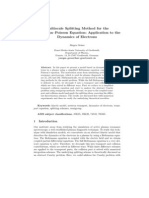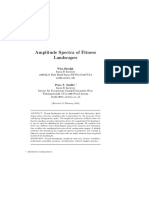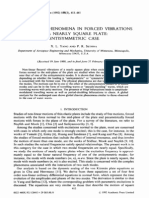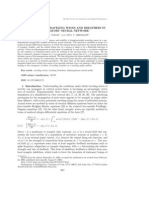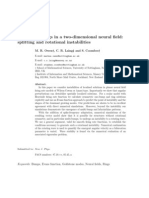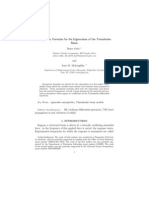Neural Fields With Fast Learning Dynamic Kernel
Neural Fields With Fast Learning Dynamic Kernel
Uploaded by
Juan Carlos Moreno OrtizCopyright:
Available Formats
Neural Fields With Fast Learning Dynamic Kernel
Neural Fields With Fast Learning Dynamic Kernel
Uploaded by
Juan Carlos Moreno OrtizCopyright
Available Formats
Share this document
Did you find this document useful?
Is this content inappropriate?
Copyright:
Available Formats
Neural Fields With Fast Learning Dynamic Kernel
Neural Fields With Fast Learning Dynamic Kernel
Uploaded by
Juan Carlos Moreno OrtizCopyright:
Available Formats
Biol Cybern (2012) 106:1526
DOI 10.1007/s00422-012-0475-9
ORIGINAL PAPER
Neural elds with fast learning dynamic kernel
A. H. Abbassian M. Fotouhi M. Heidari
Received: 16 May 2011 / Accepted: 20 January 2012 / Published online: 8 March 2012
Springer-Verlag 2012
Abstract We introduce a modied-ring-rate model based
on Hebbian-type changing synaptic connections. The exis-
tence and stability of solutions such as rest state, bumps,
and traveling waves are shown for this type of model. Three
types of kernels, namely exponential, Mexican hat, and peri-
odic synaptic connections, are considered. In the former two
cases, the existence of a rest state solution is proved and the
conditions for their stability are found. Bump solutions are
shown for two kinds of synaptic kernels, and their stability
is investigated by constructing a corresponding Evans func-
tion that holds for a specic range of values of the kernel
coefcient strength (KCS). Applying a similar method, we
consider exponential synaptic connections, where traveling
wave solutions are shown to exist. Simulation and numeri-
cal analysis are presented for all these cases to illustrate the
resulting solutions and their stability.
Keywords Neural eld Bump Traveling wave
Existence and stability
Electronic supplementary material The online version of this
article (doi:10.1007/s00422-012-0475-9) contains supplementary
material, which is available to authorized users.
A. H. Abbassian M. Fotouhi M. Heidari
School of Mathematics, Institute for Research in Fundamental
Sciences (IPM), P.O. Box 19395-5746, Tehran, Iran
e-mail: abbnet@mail.ipm.ir
M. Fotouhi (B)
Department of Mathematical Sciences, Sharif University
of Technology, P.O. Box 11365-9415, Tehran, Iran
e-mail: fotouhi@sharif.edu
M. Heidari
Department of Mechanical Engineering, Sharif University
of Technology, P.O. Box 11155-9567, Tehran, Iran
e-mail: maziar_heidari@mech.sharif.ir
Mathematics Subject Classication (2000) 35B35
35C07 45K05 92B20 92C20
1 Introduction
Neural eld models have become an active area of research
in recent years, offering novel approaches to spatiotempo-
ral pattern formation, such as the appearance of bumps and
traveling waves. Investigating the stability of such solutions
is another major challenge, even in the most simple form of
neural eld equations.
A well-known model is that proposed by Wilson and
Cowan in (1972) for a one-dimensional network of excitatory
andinhibitoryneurons. Numerically, theydemonstratedsome
of the dynamical behaviors of this model, such as the exis-
tence of solitary stationary bumps. Amari simplied this
model to a single layer of neurons and obtained analyti-
cal solutions for bump states (Amari 1977). This simplied
model was analytically tractable and allowed him to nd
explicit solutions for stationary patterns as well as to ascer-
tain their stability. Recently, some researchers have focused
on the Amari model to investigate the dynamical behavior
of neural elds (Coombes and Schmidt 2010; Coombes and
Owen 2007; Guo and Chow 2005a; Guo and Chow 2005b;
Kilpatrick and Bressloff 2010a,b; Laing et al. 2002). We use
this model in the form of the following integrodifferential
equation:
u
t
(x, t ) = u(x, t ) +
+
_
w(x y) f (u(y, t ))dy, (1)
where u(x, t ) is the average membrane potential (mean activ-
itylevel) of a neuronpopulationat position x andtime t . Also,
f (u) denotes the ring rate of a neuron with input u, being
123
16 Biol Cybern (2012) 106:1526
taken to be a Heaviside step function f (u) = H(u h),
where h is the threshold of neurons. A neuron res depend-
ing on whether or not the cell activity is above or below this
threshold. Another common choice for the ring rate func-
tion is a sigmoid function of the form f (u) =
1
1+e
(uh)
, in
which determines the steepness of the sigmoid.
The strength of the connections between neurons sep-
arated by a distance x is denoted by the function w(x),
often referred to as the synaptic coupling. (This formulation
assumes that the system is spatially homogeneous and iso-
tropic). There are several natural choices for the kernel, the
simplest ones being the exponential function w(x) =
1
2
e
|x|
and the Mexican hat function w(x) =
1
4
(1 |x|)e
|x|
. Peri-
odic synaptic connections, described by w(x) = (b sin |x| +
cos x)e
b|x|
, are also considered by some authors (Coombes
and Schmidt 2010; Elvin et al. 2010). Herein, we consider
all three types of synaptic connections.
One possible extension of the classical neural eld model
is to consider a Hebbian-type synaptic modication. This
type of dynamics may be represented as a function of the
weight variable and the activation variable at the correspond-
ing locations. In the case of a spiking neuron, a mathematical
formulation of the weight dynamics and the corresponding
membrane potentials was suggested by Gerstner et al. (2002)
to be
d
dt
w
i j
= F(w
i j
; u
i
, u
j
), (2)
where w
i j
is the synaptic connectivity weight between neu-
rons i and j . Also, the variables u
i
and u
j
stand for the
potentials of neurons i and j , respectively. In a rate model,
the membrane potential u
i
is fully characterized by its r-
ing rate f (u
i
), since the ring rate function, f , is monotone.
Thus, we can replace u
i
by f (u
i
) in the formulation (2), as
is done by some authors (Gerstner and Kistler 2002; Zhang
1996).
It is instructive to consider how such dynamics carries
over to a neural eld-type model while preserving some of
the basic assumptions such as locality and boundedness of
the synaptic modication. Here we introduce a synaptic mod-
ication in which the magnitude of the kernel is based on the
difference in activation at different locations, as shown in the
following equation:
u
t
(x, t ) = u(x, t ) +
+
_
w(x y)
_
1 + g(u(x, t ) u(y, t ))
_
f (u(y, t ))dy, (3)
where 0 is a xed parameter denoting the kernel coef-
cient strength (KCS). For = 0, our Eq. 3 will reduce to the
classical neural eld Eq. 1. The function g(u) = exp(u
2
)
is a positive, fast decreasing function with maximum value
at zero which preserves the boundedness of the synaptic
weights.
Equation 3 is suggestive of a fast dynamics where syn-
aptic change takes place on the temporal scale of the ring
rate dynamics. It has been shown very recently, however,
that such dynamics leads to synaptic instability unless some
mechanisms for boundedness or delays are takenintoaccount
(Babadi and Abbott 2010). Although this has been shown for
the case of spiking dynamics, the same also holds for fast
dynamics in the context of neural eld equations: Synchro-
nized activation will lead to stronger synaptic weight, which
in turn will result in more correlated activity and still higher
synaptic change. Here, for given function g and KCS param-
eter, the synaptic weight will remain bounded, as is expected
in a realistic biophysical setting.
Gerstner and Kistler (2002) proposed a model in which the
weight dynamics (2) depends on the correlation ring rates of
f (u
i
) and f (u
j
). In our model (3), the correlation termis rep-
resented as a function of the activation difference g(u(x, t )
u(y, t )). [For u(x, t ) and u(y, t ) less than the threshold, the
correlation term will be f (u(x, t )) f (u(y, t )) = 0; however,
in our case g(u(x, t ) u(y, t )) = 0, but the result will be
zero due to the multiplication by the term f (u(y, t )) in (3).]
Equation 3 is related to what may be called a rate model,
with u(y, t ) being correlated with the rate of ring of the neu-
rons at time t . It is, however, more common for f (u(y, t ))
to stand for the ring rate, as in (3). Since f is an increasing
function, the expression of the weight change as depending
on u and not f (u) is just a matter of scaling and does not
change the pattern of the synaptic dynamics.
Also, note that, for u less than threshold, there is no change
in the synaptic weights. f (u(y, t )) is close to zero even
though the magnitude u(x, t ) u(y, t ) = 0 will result in
g being maximum when the ring rates are below threshold.
Therefore, in this model, no correlated activity will change
the synaptic dynamics unless the activities are above thresh-
old. We believe that this is an important feature of the new
model; in contrast, in some common spiking models, any cor-
related activity may lead to synaptic modication. Finally, a
prominent feature of the proposed model is how it preserves
the synaptic pattern of activity; for example, when w(x y)
is less than zero, or in other words when the connectivity pat-
tern is inhibitory, the coactivation at locations x and y will
further decrease the synaptic weights, and therefore the shape
of the kernel remains invariant under our changing rule.
2 The rest state
In this section we investigate rest state solutions of the neural
eld (3) to show how a periodic solution can emerge from a
spatially homogeneous state. By a rest state, we mean a time-
independent and spatially uniform solution, i.e., u(x, t ) =
u
. By substituting this into (3) we obtain
123
Biol Cybern (2012) 106:1526 17
u
= (1 + ) f ( u
)W, (4)
where W =
_
R
w(x)dx. Now, we linearize (3) around the
rest state solution u
and introduce the solutions of the form
u(x, t ) = e
t
u(x) to generate the eigenvalue equation
u(x) = u(x) +(1 + ) f
( u
)(w u)(x),
where signies convolution.
Therefore, the eigenfunctions take the form u(x) = e
izx
,
and the eigenvalue can be obtained from
+1 = (1 + ) f
( u
) w(z), (5)
where w(z) is the Fourier transform of w(x).
(i) Exponential synaptic connections:
For exponential synaptic connections of the formw(x)
=
W
2
e
|x|
, w(z) =
W
1+z
2
, and we obtain the maxi-
mum eigenvalue from the following equation corre-
sponding to wavenumber z = 0 and eigenfunction
u(x) 1:
max() = (1 + ) f
( u
)W 1. (6)
We show the result for f (u) = (1 + e
(uh)
)
1
in
Fig. 1, where the red curve shows the rest state solu-
tions. The dotted curve is obtained from the equation
(1 + ) f
( u
)W 1 = 0, (7)
and shows the stability. The dashed part of the red
curve located to the right of the dotted curve (between
points
1
and
2
) corresponds to rest state solutions
that are unstable because they have some positive
eigenvalues. For kernel coefcient strength (KCS)
larger than
1
( >
1
), the neural eld (3) has only
one rest state solution and this solution is stable. Also,
for <
1
, there are three solutions, two of which
are stable and the other of which is unstable. Finally,
for =
1
, we have two rest state solutions, of which
one is stable and the other is unstable due to excitation
of the eigenfunction u(x) = 1.
(ii) Mexican hat synaptic connections:
For Mexican hat synaptic connections of the form
w(x) =
1
4
(1 |x|)e
|x|
, w(z) =
z
2
(1+z
2
)
2
. Since W =
0, there is only one stationary solution u
= 0. Spec-
trum Eq. 5 takes the form
+1 = (1 + ) f
(0)
z
2
(1 + z
2
)
2
,
2 0 2 4 6 8 10 12 14 16
0
0.2
0.4
0.6
0.8
1
*
2
f(u)=(1+e
(uh)
)
1
=10 , h=0.5
*
1
Fig. 1 The red curve shows the rest state solution for exponential syn-
aptic connections obtained by Eq. 4. The dotted curve is used for inves-
tigation of stability, being obtained by relation (7). The ( u
, ) points
located to the right of the dotted curve (indicated by the dashed red
curve) have some positive eigenvalues according to (6) and therefore
show some unstable solutions of (3). On the contrary, points to the left
of the dotted curve (indicated by solid red curve) correspond to sta-
ble solutions because all of the corresponding eigenvalues are negative.
(Color gure online)
and
max() =
1 +
4
f
(0) 1.
Let =
4
f
(0)
1; then, u
= 0 is linearly stable for
< , and unstable for > . At = , the eigen-
function u(x) = e
ix
emerges from the zero solution
u
= 0.
In Fig. 2 we plot the evolution of a neural eld for the sub-
critical, folded, and supercritical cases (i.e., < , = ,
and > ) froman initial sinusoidal perturbation (0.1 cos x)
of the uniformly zero state. For all cases, h = 0.1 and =
1.47, which results in = 14.37. Below the critical value
, neurons are stabilized to the zero solution u
= 0; for
folded value, some stripes corresponding to the eigenmode
u(x) = e
ix
appear, but above the critical value, it becomes
far from uniform and spatiotemporal patterns form.
3 Bump solutions
Throughout the rest of this paper we choose f (u) = H(uh)
for the ring rate function, where H is the Heaviside function
and h is a constant threshold. A1-bump is a time-independent
solution that satises u(x) > h for |x| < a, and u(x) < h
otherwise. Such solutions are linked to mechanisms for short-
term memory (temporary storage of information within the
brain) in prefrontal cortex (Goldman-Rakic 1995).
We restrict attention to symmetric solutions, for which
u(x) = u(x). Note that this constraint is natural because
123
18 Biol Cybern (2012) 106:1526
X
t
20 10 0 10 20
0
10
20
30
40
50
60
70
80
90
0.08
0.06
0.04
0.02
0
0.02
0.04
0.06
0.08
0.1
X
t
20 10 0 10 20
0
10
20
30
40
50
60
70
80
90
0
0.1
0.2
0.3
0.4
0.5
0.6
X
t
20 10 0 10 20
0
10
20
30
40
50
60
70
80
90
0.2
0
0.2
0.4
0.6
0.8
1
1.2
1.4
1.6
1.8
Fig. 2 Solution simulations of Eq. 3 for Mexican hat synaptic con-
nections plotted for h = 0.1, = 1.47, and the initial condi-
tion u(x, 0) = 0.1 cos x, which is considered as a perturbation of
u(x, 0) = 0. For < (top left image) the solution converges uni-
formly to zero. For = (top right image) stripes emerge, whereas
for > (bottom image) some patterns emerge due to instability of
the zero solution in this case
of the symmetric form of Eq. 3. Substituting this form into
(3), we obtain
u(x) =
a
_
a
w(x y)
_
1 + g(u(x) u(y))
_
dy. (8)
Since the solutions are continuous, we can assume
u(a) = h. (9)
For the standard neural eld model ( = 0), Amari inves-
tigated the stability of 1-bump solutions (Amari 1977). He
showed that u
0
(x) =
_
a+x
a+x
w(y)dy is a 1-bump solution if
h = u
0
(a) =
2a
_
0
w(y)dy.
According to the Amari approaches for = 0, there exist
1-bump solutions if
0 < h W
= max
0x
x
_
0
w(y)dy,
which are stable only if w(2a) < 0. We show these results
in Figs. 3 and 4, where solid lines indicate the threshold h as
a function of the bump radius a. For the general case (when
> 0), we apply perturbation theory using the KCS param-
eter as the perturbation parameter to construct the solution
to the modied neural eld model (3). Suppose that the solu-
tion takes the form u
(x) = u
0
(x) + u
1
(x) + O(
2
) and
that h
= h
0
+ h
1
+O(
2
). We summarize the conditions
(8) and (9) for the existence of a 1-bump into the relation
G(, h, u) = (0, 0), where
G(, h, u)
=
u(x)
a
_
a
w(x y)
_
1 + g(u(x) u(y))
_
dy
u(a) h
.
Consider G : R
+
R
+
C
b
R C
b
, where C
b
is the
space of bounded, continuous, and even functions. We know
that, for = 0, there exists (h
0
, u
0
) with respect to 1-bumps
such that G(0, h
0
, u
0
) = (0, 0). Now, the existence of these
solutions is proven in the following theorem:
123
Biol Cybern (2012) 106:1526 19
0 0.5 1 1.5 2 2.5 3
0
0.02
0.04
0.06
0.08
0.1
0.12
a
h
=0
=0.1
Fig. 3 The solid curve shows the bumps radius a for several values of
the threshold h when synaptic connectivity corresponds to the Mexican
hat kernel and = 0 in model (3). Similarly, the dashed curve shows
the existence of bump solutions for = 0.1 resulting fromperturbation
theory
0 1 2 3 4 5 6 7 8 9 10
0
0.2
0.4
0.6
0.8
1
1.2
1.4
1.6
1.8
2
a
h
=0
=0.1
Fig. 4 The curves show the radius of bumps for = 0 (solid curve)
and = 0.1 (dashed curve) resulting from perturbation theory for
periodic synaptic connectivity
Theorem 1 For 0 < 1, there exists a curve (h
, u
)
such that G(, h
, u
) = (0, 0).
Proof According to the implicit function theorem, it is nec-
essary to show that
G
(h,u)
|
=0
is invertible. This is trivial
from the following calculation:
G
(h, u)
|
=0
(k, v)
=
d
dt
G(0, h
0
+t k, u
0
+t v) =
_
v(x)
v(a) k
_
.
The above theorem shows the existence of the perturbed
solutions. We now investigate whether, for 0 < 1, all
1-bump solutions are solutions (h
, u
) from the previous
theorem. Let (h, u) be a 1-bump solution with radius a that
satises conditions (8) and (9). Then,
|h h
0
| = |u(a)
a
_
a
w(a y)dy|
= |
a
_
a
w(a y)g(h u(y))dy|
|w(y)|dy.
Thus, h tends to h
0
as approaches zero. We have the same
result with respect to u, i.e.,
|u(x) u
0
(x)| |
a
_
a
w(x y)g(u(x) u(y))dy|
|w(y)|dy.
Therefore, for 0 < 1, the solution (h, u) corresponding
to a constant bump of width 2a is close to (h
0
, u
0
). On the
other hand, according to the implicit function theorem in the
previous theorem, all solutions in a neighborhood of (h
0
, u
0
)
are obtained from the curve (h
, u
).
Now, we approximate the solution by perturbation the-
ory, so let u
(x) = u
0
(x) + u
1
(x) + O(
2
) and h
=
h
0
+ h
1
+ O(
2
) be the solution corresponding to bump
width 2a. Substituting into relations (8) and (9) and differ-
entiating with respect to , we obtain
u
1
(x) =
a
_
a
w(x y)g(u
0
(x) u
0
(y))dy,
h
1
= u
1
(a).
We calculate h
1
and u
1
for different values of a and for
Mexican hat (w(x) =
1
4
(1 |x|)e
|x|
) or periodic synaptic
connections (w(x) = (b sin |x| + cos |x|)e
b|x|
). Figures 3
and4showthe dependencyof h
ona for these cases. Inthese
cases, one sees that h
1
> 0, so we need a larger threshold
h
to obtain a bump with the same width as for the classi-
cal model. This may be interpreted as a lower sensitivity to
synaptic modication; for example, in Fig. 3, we see that,
for a constant threshold, the bump width increases with
for a > 0.5 (width more than 1) but decreases for a < 0.5
(width less than 1). In the case of a = 0.5, as increases,
two bumps emerge, with radius less than and more than 0.5.
In the case of periodic synaptic connections, the perturba-
tion theory can only be applied for bump radius smaller than
a < 2 since the value of h
1
grows too much for larger bump
radius as indicated in Fig. 4. Figures 5, 6, and 7 show the
dependence of the bump width on for several cases.
123
20 Biol Cybern (2012) 106:1526
10 8 6 4 2 0 2 4 6 8 10
0.04
0.02
0
0.02
0.04
0.06
0.08
0.1
0.12
0.14
X
U
=0
=0.09
h=0.09
Fig. 5 Abump of width 0.8 (in the case a < 0.5) for = 0 is changed
to a bump of width 0.6 for = 0.09 when h = 0.09
10 8 6 4 2 0 2 4 6 8 10
0.1
0.05
0
0.05
0.1
0.15
0.2
0.25
X
U
=0
=0.11
h=0.06
Fig. 6 A bump of width 2 (in the case a > 0.5) for = 0 is changed
to a bump of width 2.2 for = 0.11 when h = 0.06
To understand the accuracy of the results of the perturba-
tion theory, the nonlinear Eq. 8 was also solved numerically.
Since its solution is symmetric, the domain was scaled to
[0,1]. So, for a xed value of the threshold h, Eqs. 8 and 9
are solved to obtain a for different values of . The results
for the dependence of a on for the Mexican hat kernel and
h = 0.03 are shown in Fig. 8. The plus symbols indicate the
10 8 6 4 2 0 2 4 6 8 10
0.1
0.05
0
0.05
0.1
0.15
0.2
0.25
X
U
=0.017
=0
=0.017
h=0.09
Fig. 7 A bump of width 1 (in the case a = 0.5) for = 0 is changed
to bumps with widths of 0.8 and 1.2 for = 0.017 when h = 0.09
radius of bumps as computed by the perturbation method.
The results for the two cases differ by less than approxi-
mately 4% for < 1. Note that, in the perturbation method,
we x the radius a then perturb the bump solution u(x) and
the threshold value h in Eqs. 8 and 9. We can then calculate
the bump width for constant h using the dashed line in Fig. 3.
Now we investigate the stability of these solutions. Lin-
earizing (3) around the bump solution u
with radius a, we
obtain
v
t
= L
v, where
L
v = v(x) +
a
_
a
w(x y)g
(u
(x) u
(y))
(v(x) v(y))dy
+
w(a + x)
|u
(a)|
(1 + g(h
(x)))v(a)
+
w(a + x)
|u
(a)|
(1 + g(h
(x)))v(a)
= v(x) +
(x)v(x) +
a
_
a
K
(x, y)v(y)dy
0 0.2 0.4 0.6 0.8 1 1.2 1.4 1.6 1.8 2
0.01
0.02
0.03
0.04
0.05
0.06
0.07
a
0 0.2 0.4 0.6 0.8 1 1.2 1.4 1.6 1.8 2
1.6
1.8
2
2.2
2.4
2.6
2.8
3
a
Fig. 8 The dependence of a on obtained from the numerical solu-
tion of Eq. 8 for the Mexican hat kernel and a xed threshold h = 0.03.
(Note that, for every , we have two bumps.) The plus symbols indicate
the bump radii computed by the perturbation method. The differences
between the two computations are less than 4% for < 1
123
Biol Cybern (2012) 106:1526 21
+f
1
(x)v(a) + f
2
(x)v(a),
where
(x) =
_
a
a
w(x y)g
(u
(x) u
(y))dy
and K
(x, y) = w(x y)g
(u
(x) u
(y)). Let S
v =
v(x) +
(x)v(x) +
_
a
a
K
(x, y)v(y)dy; then, for
0 < 1, S
is invertible. On the other hand the non-
local operator v f
1
(x)v(a) + f
2
(x)v(a) is compact,
hence L
is a Fredholm operator with index zero, and its
essential spectrum is equal to the essential spectrum of S
(see Davies 2007). Now, considering the eigenvalue equation
L
v = v, we can write
(S
I )v + f
1
(x)v(a) + f
2
(x)v(a) = 0.
For / SpecS
, we have
v(x) = v(a)[(I S
)
1
f
1
](x)
+v(a)[(I S
)
1
f
2
](x).
Letting x = a, a in the last equation, we deduce that the
following matrix should be singular:
A=
_
[(I S
)
1
f
1
](a) 1 [(I S
)
1
f
2
](a)
[(I S
)
1
f
1
](a) [(I S
)
1
f
2
](a) 1
_
.
The equation det A = 0 plays the role of an Evans func-
tion for the stability in this case. We prove this claim in the
following theorem:
Theorem 2 For sufciently small values of , 1-bump solu-
tion u
of (3) is linearly stable if and only if = 0 is a simple
root of det A = 0 and the other roots are located on the left
side of the complex plane.
Proof First of all note that, accordingtothe translationinvari-
ance of Eq. 3, the linear operator L
has an eigenvalue equal
to zero and the solution u
is linearly stable if the eigenvalue
= 0 is simple and the rest of the spectrum is located in
the left side of the plane. We denote A = { / SpecS
:
det[A] = 0}. The above calculations show that SpecL
A SpecS
. It is sufcient to show that SpecS
{z C :
Rez < 0} to complete the proof. However, S
is a per-
turbation of the operator I with the operator
(x)v(x)+
_
a
a
K
(x, y)v(y)dy. So, its spectrum is located in
| +1| (
+ K),
where K = sup
xR
_
a
a
|K
(x, y)|dy, and it is bounded
because of the properties of the functions g and w. So, for
sufciently small , SpecS
is located in the left side of the
complex plane.
Remark 3 Note that |g
(u)|
_
2
e
for all u R, so K E
and
E, where
E =
_
2
e
|w(y)|dy.
Table 1 Approximation of Evans function roots for Mexican hat syn-
aptic connections obtained from (10) for two domain discretizations
(N = 10 and 20), radius bump a = 1, = 0.1, and h = 0.018
N = 10 N = 20
1
= 0.00012
1
= 0.00064
12
= 1.00035
2
= 0.10402
2
= 0.10354
13
= 0.99959
3
= 0.99952
3
= 0.99972
14
= 0.99946
4
= 0.99957
4
= 1.00016
15
= 0.99951
5
= 0.99966
5
= 0.99965
16
= 0.99954
6
= 0.99978
6
= 0.99948
17
= 0.99999
7
= 0.99983
7
= 1.00052 +0.00010i
18
= 0.99984
8
= 1.00011
8
= 1.00054 +0.00017i
19
= 0.99997
9
= 1.00018
9
= 1.00052 0.00010i
20
= 0.99980
10
= 1.00047
10
= 1.00054 0.00017i
21
= 1.00020
11
= 1.00051
11
= 1.00038
Thus, in the Mexican hat case, Theorem 2 is valid for the
range of values of the KCS parameter <
1
8e
3
1.58,
whereas for the periodic kernel it is sufcient to have <
_
e
32
b
1+b
2
.
Now, we approximate the roots of the Evans function
det A = 0 by considering (I S
)h
i
= f
i
for i = 1, 2. If
we discretize the interval a x a into N equal parts by
points x
j
= a +
2aj
N
for 0 j N, then
f
i
(x
j
) = (I S
)h
i
(x
j
)
= ( +1)h
i
j
j
h
i
j
2 a
N
N
l=1
k
jl
h
i
l
,
where h
i
j
= h
i
(x
j
),
j
(x
j
) and k
jl
= K
(x
j
, x
l
).
We thereby arrive at a (N + 1) (N + 1) system whose
coefcient matrix is invertible for small values of . There-
fore, h
i
0
and h
i
N
are approximations for [(I S
)
1
f
i
](a)
and [(I S
)
1
f
i
](a), respectively, so the Evans function
det A = 0 becomes
det
_
h
1
N
1 h
2
N
h
1
0
h
2
0
1
_
= 0. (10)
We summarize the results for Mexican hat and periodic
synaptic connections, bump radius a = 1, = 0.1, and two
different discretizations N in Tables 1 and 2. Compare the
results with the case = 0 and its spectrum {0, 0.10417,
1} for Mexican hat and {0, 0.323, 1} for periodic synap-
tic connections (see Bressloff 2009; Guo and Chow 2005b).
Note that = 0 is an eigenvalue for all values of . Given
the discretization of our complicated operators, we expect
1
(the nearest approximate eigenvalue to zero) not equal to
zero. We can conclude that, except for
1
, the other roots of
the Evans function det A = 0 will have negative real parts.
Therefore, the bump solution u
is linearly stable in both
cases. Figures 9 and 10 show some neural eld dynamical
evolutions for the Mexicanhat case for different widthvalues.
123
22 Biol Cybern (2012) 106:1526
Table 2 Approximation of
Evans function roots for
periodic synaptic connections
obtained from (10) for two
domain discretizations (N = 10
and 20), bump radius a = 1,
= 0.1, h = 0.67, and b = 0.4
N = 10 N = 20
1
= 0.13293
1
= 0.13835
12
= 0.95931
2
= 0.24195
2
= 0.23690
13
= 1.07625
3
= 1.01482 +0.03695i
3
= 1.01147 +0.04585i
14
= 0.96857
4
= 1.01644 +0.04290i
4
= 1.01120 0.03682i
15
= 0.96184
5
= 0.97535
5
= 1.01120 +0.03682i
16
= 0.95929
6
= 0.97795
6
= 1.01147 0.04585i
17
= 0.98579
7
= 1.02205
7
= 1.08102
18
= 1.06873
8
= 1.05084
8
= 1.02615
19
= 1.05733
9
= 1.07312
9
= 0.96183
20
= 1.04499
10
= 1.01482 0.03695i
10
= 0.96913
21
= 0.99073
11
= 1.01644 0.04290i
11
= 1.01284
X
t
10 5 0 5 10
0
10
20
30
40
50
60
70
80
90
0.02
0
0.02
0.04
0.06
0.08
0.1
0.12
0.14
X
t
10 5 0 5 10
0
10
20
30
40
50
60
70
80
90
0.02
0
0.02
0.04
0.06
0.08
0.1
Fig. 9 Simulated solution for Mexican hat synaptic connections with initial condition u(x, 0) equal to a perturbation of the bump solution with
width 0.8 for = 0 (left) and = 0.1 (right), showing that these bump solutions are unstable in both cases and that the bumps could disappear
X
t
30 20 10 0 10 20 30
0
10
20
30
40
50
60
70
80
90
0.04
0.02
0
0.02
0.04
0.06
0.08
0.1
0.12
0.14
0.16
t
30 20 10 0 10 20 30
0
10
20
30
40
50
60
70
80
90
0.05
0
0.05
0.1
0.15
X
Fig. 10 Simulated solutions for Mexican hat kernel and KCS value = 0.1 when the initial condition is a perturbation of bumps of width 1.2
(left) and 4 (right), showing that both bumps are stable
The initial value u(x, 0) in all cases is equal to a perturbation
of u
(x).
Now, we estimate the spectrum using a different method
by using the approximation operator
_
I S
_
1
in matrix
A with
(I S
)
1
= (( +1)I T
)
1
=
1
+1
(I
+1
T
)
1
1
+1
(I +
+1
T
),
where (T
v)(x) =
(x)v(x)+
_
a
a
K
(x, y)v(y)dy. Anal-
ogously to in the previous calculation, the domain [a, a] is
descretized into N subdomains, and the roots of the Evans
function det A = 0 are calculated. The results are listed in
Tables 3 and 4 for the Mexican hat and periodic kernel cases,
respectively.
4 Traveling wave
To study the existence of traveling wave solutions to Eq. 3,
we consider the change of variables = x ct and u(x, t ) =
U(x ct ). Equation 3 then becomes
123
Biol Cybern (2012) 106:1526 23
Table 3 Approximation of Evans function roots for Mexican hat syn-
aptic connections with bump radius a = 1 and = 0.1
N = 10 N = 20
1
= 0.00012
1
= 0.00064
2
= 0.10402
2
= 0.10354
3
= 0.99981
3
= 0.99989
4
= 0.99986
4
= 0.99995
We use an approximation of the operator (I S
)
1
to solve Eq. 10
for the two values N = 10 and 20
Table 4 Approximation of Evans function roots for periodic synaptic
connections with bump radius a = 1 and = 0.1
N = 10 N = 20
1
= 0.12929
1
= 0.13386
2
= 0.24524
2
= 0.24078
3
= 1.05713
3
= 1.06032
4
= 1.09780
4
= 1.10049
We use an approximation of the operator (I S
)
1
to solve Eq. 10
for the two values N = 10 and 20
cU
+U =
w( )
_
1 + g((U() U())
_
H(U() h)d. (11)
We focus on the exponential synaptic connectivity w(x) =
1
2
e
|x|
in this section; for = 0 we know that there exists a
stable traveling wave for such exponential synaptic
connections, which we call U
0
(). We try to prove the exis-
tence of the traveling wave solution for (11) using the per-
turbation theory (Fig. 11).
Since the equation is translation invariant, we can assume
that this solution satises U() > h for < 0 and U() < h
for > 0 and U(0) = h. Then, Eq. 11 takes the form
cU
+U = F(, ),
30 20 10 0 10 20 30
0
0.2
0.4
0.6
0.8
1
1.2
1.4
U
=0
=0.1
Fig. 11 Traveling wave solutions for = 0 and = 0.1 for exponen-
tial connectivity
where
F(, ) =
0
_
w( )
_
1 + g((U() U())
_
d.
(12)
This differential equation has the solution
U() = e
/c
h
1
c
_
0
e
/c
F(, )d
. (13)
Requiring the solution to remain bounded as
implies that h must satisfy the condition
h =
1
|c|
+
_
0
e
/|c|
F(, si gn(c))d.
For c > 0, the solution (13) can be written in the form
U() =
1
c
+
_
e
()/c
F(, )d.
In the case = 0 we have h
0
=
1
2(1+c)
for c > 0, and in
the general case the traveling wave solution is achieved from
the relation G(, h, U) = (0, 0), where G : RRC
b
R C
b
is dened as
G(, h, U) =
ch
+
_
0
e
/c
F(, )d
cU()
+
_
e
()/c
F(, )d
,
where C
b
is the space of continuous and bounded func-
tions. Note that F(, ) > 0 because w(x) > 0, and so
if G(, h, U) = (0, 0), then U(0) = h and U() < h for
> 0 as well as U() > h for < 0.
Theorem 4 If c = 0, there is a curve (h
, u
) for which
G(, h
, u
) = (0, 0) for 0 < 1.
Proof Note that G(0, h
0
, U
0
) = (0, 0). It is necessary to
show that
G
(h,u)
|
(0,h
0
,U
0
)
is invertible. However, one can eas-
ily see that
G
(h, u)
|
(0,h
0
,U
0
)
(b, V) =
_
cb
cV()
_
,
so it is invertible for c = 0.
The traveling wave solution is unique for 0 < 1
because (as for the bump solution), if G(, h, U) = (0, 0),
the relation (12) implies that F(0, ) F(, ) (1 +
)F(0, ), so we can conclude that
|h h
0
| h
0
, |U() U
0
()| U
0
().
123
24 Biol Cybern (2012) 106:1526
0 0.5 1 1.5 2 2.5 3 3.5 4 4.5 5
0
0.05
0.1
0.15
0.2
0.25
0.3
0.35
0.4
0.45
0.5
c
h
=0.1
=0
Fig. 12 The curves showthe existence of different travelingwave solu-
tions with speed c as h varies for KCS values = 0 (solid) and = 0.1
(dashed), showing that the traveling wave speed increases with the KCS
parameter . Using the same threshold h for both cases = 0 and
= 0.1, the traveling wave speed in the case = 0.1 is greater
So, (h, U) is near to (h
0
, U
0
) and the implicit function the-
orem implies that (h, U) coincides with (h
, U
).
Now, we apply the perturbation theory to approximate the
solution by substituting U
() = U
0
() +U
1
() +O(
2
)
and h
= h
0
+ h
1
+ O(
2
) into G(, h, U) = (0, 0).
Then,
h
1
=
1
c
_
0
e
/c
F
(0, )d,
U
1
() =
1
c
e
()/c
F
(0, )d,
where
F
(0, ) =
0
_
w( )g((U
0
() U
0
())d.
As we can see from the above relation that
F
(0, ) > 0, we
can conclude that h
1
> 0, so h
> h
0
. As previously shown
in the case of the bump solution, we need a higher threshold
(lower sensitivity) to obtain the same traveling speed as in the
classical model. Figure 12 shows the dependence of h
on c
for = 0 and = 0.1 for exponential synaptic connectivity,
i.e., w(x) =
1
2
e
|x|
.
To investigate stability in (U
, h
), we should nd the
spectrum of the following operator (see Sandstede 2007):
L
V = cV
V +w()
_
1 + g(U
() h
)
_
V(0)
|U
(0)|
+
0
_
w( )g
(U
() U
())
(V() V())d
= cV
V +
()V
0
_
(, )V()d
+f
()V(0),
where
() =
_
0
w( )g
(U
() U
())d,
K
(, ) = w( )g
(U
() U
()), and f
() =
w()
|U
(0)|
[1+ g(U
()h
)]. Now, dene operators S and K
as SV = cV
V and KV =
V
_
0
(, )V()d.
The operator S is invertible, and its inverse S
1
: C
b
C
b
is dened as
S
1
F =
1
c
+
_
e
()/c
F()d.
On the other hand, K is bounded, so for small values of ,
S
= S+ Kis invertible too (provided that K S
1
<
1). Note that L
V = S
V + f
()V(0) is a Fredholm oper-
ator and the essential spectra of L
and S
are equal (Davies
2007). So, to investigate the point spectrum (eigenvalues) of
L
, rst suppose that / SpecS
; then, we should have
[(I S
)
1
f
](0) = 1. (14)
Secondly, is is possible that SpecS
, but S
is a pertur-
bation of the operator S, so SpecS
SpecS+B(0, K),
where B is the ball with center zero and radius K. On
the other hand, for values of such that Re(
+1
c
) > 0, the
operator S I : C
b
C
b
is invertible with continuous
inverse
(S I )
1
F =
1
c
+
_
e
(+1)
c
()
F()d.
Thus, SpecS { : Re
1
c
}, and for small we deduce
that the spectrum of S
is located on the left side of the
complex plane. We summarize the stability results in the fol-
lowing theorem:
Theorem 5 For sufciently small values of , the traveling
wave solution U
of (3) is linearly stable if and only if = 0
is a simple root of (14) and the other roots are located on the
left side of the complex plane.
Remark 6 Since |g
(u)|
_
2
e
, we have K 2
_
2
e
. So,
for small values of KCS, <
_
e
8
min{1,
1
c
}, S
is invert-
ible, and the theorems assertion holds.
We show the dynamical evolution of (3) for initial value
u(x, 0) = U
0
(x) and = 0.1 from Fig. 13. The result tends
to the traveling wave solution U
(x ct ). Finally, we men-
tion that the same results are valid for negative speed c, i.e.,
h
> h
0
, in which case we also have Theorem 5.
123
Biol Cybern (2012) 106:1526 25
X
t
40 30 20 10 0 10 20 30 40
0
10
20
30
40
50
60
70
80
90
0
0.2
0.4
0.6
0.8
1
Fig. 13 Simulated solution (3) for = 0.1 and h = 0.23 and initial
condition being a perturbation of a traveling wave solution (with speed
c = 1.3), verifying the stability of this traveling wave
5 Discussion
In this paper a modied neural eld equation based on a
Hebbian type of synaptic dynamics is introduced, and the
existence and stability of the rest state solution are demon-
strated for both exponential and Mexican hat kernels. Also,
the existence of bump solutions is proved (Theorem 1). The
study of the stability of these solutions using the Evans func-
tion technique was rather complicated as applied to the oper-
ator corresponding to the modied neural eld equation, but
was shown to hold (Theorem 2) for a specic range of val-
ues of a parameter [here called the kernel coefcient strength
(KCS)]. Applying similar methods, we considered exponen-
tial synaptic connections where traveling wave solutions are
shown to exist (Theorem 4,5). More specifically, as shown
in Fig. 12, the speed of the traveling wave solution is faster
than in the classical model, and as shown in Figs. 3 and 4,
the radius of the stable bump solution is greater than in the
classical model, whereas the radius of the unstable solution
will be smaller in the new model.
Introduction of Hebbian-type learning into the neural eld
equation has been a subject of interest for many years (Zhang
1996), while correlation-type learning based on the original
Hebbian rule is the standard approach in literature. Later
efforts have tried to overcome some of its shortcomings such
as a need for synaptic normalization, as well as the impor-
tance of pre- and postsynaptic activity including relative tim-
ing on synaptic efcacy. In general, such modication of the
standard model makes mathematical analysis of the existence
and stability of the solutions a daunting task. Although sim-
ulation results are suggestive as a rst step, rigorous mathe-
matical analysis needs to be established to support the results.
Takeuchi et al. (1979) were among the rst to consider such
analysis for the case based on slow dynamics. The present
model may be interpreted as an attempt to include synaptic
modications with fast dynamics into the standard model.
Awell-known example of such fast dynamics in literature on
spiking neurons is spiking timing synaptic plasticity (STDP).
There are, of course, other biophysical constraints such as
boundedness of synaptic weights, which is taken into the
account in the present model. Another important feature is
the invariance of the kernel shape (e.g., Mexican hat) despite
synaptic changes with faster dynamics. This is expected in
any plausible model of neural data in which the shape of the
kernel is given as a xed property of the network, while Heb-
bian-type learning results in synaptic modication based on
local correlated activity (the locality of which is determined
by the shape of the kernel).
Although the present model is greatly simplied in terms
of introducing synaptic dynamics into a neural eld type of
model, even in this case the question of the existence and
stability of solutions is nontrivial. Further work needs to be
done to show how such synaptic modication will behave
under slower synaptic time constant dynamics.
Acknowledgements This research is supported in part by a grant from
IPM (1389).
References
Amari S (1977) Dynamics of patternformationinlateral-inhibitiontype
neural elds. Biol Cybern 27:7787
Babadi B, Abbott LF (2010) Intrinsic stability of temporally
shifted spike-timing dependent plasticity. PLoS Comput Biol
6(11):e1000961. doi:10.1371/journal.pcbi.1000961
Bressloff PC(2009) Lectures in mathematical neuroscience, mathemat-
ical biology. IAS/Park City Math Ser, vol. 14. American Mathe-
matical Society, Providence, RI, pp 293398
Coombes S, Schmidt H (2010) Neural elds with sigmoidal ring rates:
approximate solutions. Discr Contin Dyn Syst 28:13691379
Coombes S, Owen MR (2007) Exotic dynamics in a ring rate model
of neural tissue with threshold accommodation. Fluids and waves:
recent trends in applied analysis. Contemp Math, vol 440. AMS,
Providence, RI, pp 123144
Davies EB (2007) Linear operators and their spectra. Cambridge Uni-
versity Press, Cambridge
Elvin AJ, Laing CR, McLachlan RI, Roberts MG (2010) Exploiting the
Hamiltonian structure of a neural eld model. Phys D239:537546
Ermentrout GB, Terman DH (2010) Mathematical foundations of neu-
roscience. Interdisciplinary applied mathematics, vol 35. Springer,
New York
Gerstner W, Kistler W (2002) Mathematical formulations of Hebbian
learning. Biol Cybern 87:404415
Goldman-Rakic PS (1995) Cellular basis of working memory. Neuron
14:477485
Guo Y, Chow CC (2005a) Existence and stability of standing pulses in
neural networks: I existence. SIAM J Appl Dyn Syst 4:217248
Guo Y, Chow CC (2005b) Existence and stability of standing pulses in
neural networks: II stability. SIAM J Appl Dyn Syst 4:249281
Kilpatrick ZP, Bressloff PC (2010a) Effects of synaptic depression and
adaptation on spatiotemporal dynamics of an excitatory neuronal
network. Phys D 239(9):547560
Kilpatrick ZP, Bressloff PC (2010b) Stability of bumps in piece-
wise smooth neural elds with nonlinear adaptation. Phys D
239(12):10481060
123
26 Biol Cybern (2012) 106:1526
Laing CR, Troy WC, Gutkin B, Ermentrout GB (2002) Multiple bumps
in a neuronal model of working memory. SIAM J Appl Math
63:6297
Sandstede B (2007) Evans functions and nonlinear stability of travel-
ling waves in neuronal network models. Int J Bifur Chaos 17:2693
2704
Takeuchi A, Amari S (1979) Formation of topographic maps and
columnar microstructures in nerve elds. Biol Cybern 35(2):
6372
Wilson HR, Cowan JD (1972) Excitatory and inhibitory interactions in
localized populations of model neurons. Biophys J 12:124
Zhang K (1996) Representation of spatial orientation by the intrinsic
dynamics of the head-direction cell ensemble: a theory. J Neurosci
16(6):21122126
123
You might also like
- GraceMonokoteZ106HY PDFDocument2 pagesGraceMonokoteZ106HY PDFJovanni RodriguezNo ratings yet
- NSol V4 - 6 ManualDocument41 pagesNSol V4 - 6 ManualDaniel AyosaNo ratings yet
- AFPX 407 LeafletDocument2 pagesAFPX 407 Leaflethelbertortiz100% (1)
- Path-Integral Evolution of Chaos Embedded in Noise: Duffing Neocortical AnalogDocument23 pagesPath-Integral Evolution of Chaos Embedded in Noise: Duffing Neocortical AnalogLester IngberNo ratings yet
- Roland Potthast and Peter Beim Graben - Existence and Properties of Solutions For Neural Field EquationsDocument24 pagesRoland Potthast and Peter Beim Graben - Existence and Properties of Solutions For Neural Field EquationsNeerFamNo ratings yet
- FDM, Fem, FVMDocument32 pagesFDM, Fem, FVMRaj EaswarmoorthiNo ratings yet
- On The Spectra of Randomly Perturbed Expanding Maps: Mathematical PhysicsDocument32 pagesOn The Spectra of Randomly Perturbed Expanding Maps: Mathematical PhysicskartikNo ratings yet
- 8.2 Finite Difference, Finite Element and Finite Volume Methods For Partial Differential EquationsDocument32 pages8.2 Finite Difference, Finite Element and Finite Volume Methods For Partial Differential EquationsgbrajtmNo ratings yet
- B_NODY.0000009939.57092.adDocument31 pagesB_NODY.0000009939.57092.adTarun NaskarNo ratings yet
- Wiggly Relativistic Strings: UFIFT-HEP-92-10 Hep-Ph/9210210Document10 pagesWiggly Relativistic Strings: UFIFT-HEP-92-10 Hep-Ph/9210210BattleAppleNo ratings yet
- Paul C. Bressloff and Zachary P. Kilpatrick - Two-Dimensional Bumps in Piecewise Smooth Neural Fields With Synaptic DepressionDocument30 pagesPaul C. Bressloff and Zachary P. Kilpatrick - Two-Dimensional Bumps in Piecewise Smooth Neural Fields With Synaptic DepressionNeerFamNo ratings yet
- Jun Ma Et Al - The Instability of The Spiral Wave Induced by The Deformation of Elastic Excitable MediaDocument11 pagesJun Ma Et Al - The Instability of The Spiral Wave Induced by The Deformation of Elastic Excitable MediaGretymjNo ratings yet
- Network Models of Quantum Percolation and Their Field-Theory RepresentationsDocument13 pagesNetwork Models of Quantum Percolation and Their Field-Theory RepresentationsBayer MitrovicNo ratings yet
- Fluctuations 3-08Document31 pagesFluctuations 3-08Muhammad YounasNo ratings yet
- Multiscale Splitting Method For The Boltzmann-Poisson Equation: Application To The Dynamics of ElectronsDocument14 pagesMultiscale Splitting Method For The Boltzmann-Poisson Equation: Application To The Dynamics of ElectronsLuis Alberto FuentesNo ratings yet
- Amplitude Spectra Fit LandscapeDocument27 pagesAmplitude Spectra Fit LandscapebarrospiresNo ratings yet
- The Skinner-Rusk Approach For VakonomicDocument13 pagesThe Skinner-Rusk Approach For VakonomicChernet TugeNo ratings yet
- S. Coombes and P. C. Bressloff - Saltatory Waves in The Spike-Diffuse-Spike Model of Active Dendritic SpinesDocument4 pagesS. Coombes and P. C. Bressloff - Saltatory Waves in The Spike-Diffuse-Spike Model of Active Dendritic SpinesNeerFamNo ratings yet
- Physica/: Time-Dependent Behavior of Granular Material in A Vibrating BoxDocument20 pagesPhysica/: Time-Dependent Behavior of Granular Material in A Vibrating BoxjtorerocNo ratings yet
- Energy Dissipation in Body-Forced Plane Shear FlowDocument10 pagesEnergy Dissipation in Body-Forced Plane Shear FlowMichael BuentelloNo ratings yet
- Dynamical Volume Element in Scale-Invariant and Supergravity TheoriesDocument6 pagesDynamical Volume Element in Scale-Invariant and Supergravity TheoriesCroco AliNo ratings yet
- Kuramoto 1984Document18 pagesKuramoto 1984Lambu CarmelNo ratings yet
- HoMa1981Document23 pagesHoMa1981Souvik ChakrabortyNo ratings yet
- Triple LinkageDocument13 pagesTriple Linkagepalerm00No ratings yet
- Non-Linear Phenomena in Forced Vibrations of A Nearly Square Plate: Antisymmetric CaseDocument29 pagesNon-Linear Phenomena in Forced Vibrations of A Nearly Square Plate: Antisymmetric Casechirag_palan1987No ratings yet
- 2004 FDFEand FVmethodsfor PDEs Handbook Material ModellingDocument33 pages2004 FDFEand FVmethodsfor PDEs Handbook Material ModellingAhmed KhalidNo ratings yet
- P. C. Bressloff Et Al - Oscillatory Waves in Inhomogeneous Neural MediaDocument4 pagesP. C. Bressloff Et Al - Oscillatory Waves in Inhomogeneous Neural MediaNeerFamNo ratings yet
- Modeling of Large Deformations of Hyperelastic MaterialsDocument4 pagesModeling of Large Deformations of Hyperelastic MaterialsSEP-PublisherNo ratings yet
- 1 s2.0 S000187081930026X MainDocument29 pages1 s2.0 S000187081930026X Mainfordgt90No ratings yet
- c2 PDFDocument25 pagesc2 PDFmikealex750No ratings yet
- Stefanos E. Folias and Paul C. Bressloff - Stimulus-Locked Travelling Waves and Breathers in An Excitatory Neural NetworkDocument26 pagesStefanos E. Folias and Paul C. Bressloff - Stimulus-Locked Travelling Waves and Breathers in An Excitatory Neural NetworkNeerFamNo ratings yet
- Giuseppe Saccomandi - Elastic Rods, Weierstrass' Theory and Special Travelling Waves Solutions With Compact SupportDocument9 pagesGiuseppe Saccomandi - Elastic Rods, Weierstrass' Theory and Special Travelling Waves Solutions With Compact SupportLymesNo ratings yet
- M. R. Owen, C. R. Laing and S. Coombes - Bumps and Rings in A Two-Dimensional Neural Eld: Splitting and Rotational InstabilitiesDocument23 pagesM. R. Owen, C. R. Laing and S. Coombes - Bumps and Rings in A Two-Dimensional Neural Eld: Splitting and Rotational InstabilitiesJmasnNo ratings yet
- Entropy of A Classical Stochastic Field and Cosmological PerturbationsDocument10 pagesEntropy of A Classical Stochastic Field and Cosmological PerturbationsJ Christian OdehnalNo ratings yet
- 1997 Harten Lax VanLeerDocument28 pages1997 Harten Lax VanLeerPamela MaldonadoNo ratings yet
- Asymptotic Formulas For The Eigenvalues of The Timoshenko BeamDocument39 pagesAsymptotic Formulas For The Eigenvalues of The Timoshenko Beamtosha_flNo ratings yet
- Method of Identifying Nonlinear Characteristic of Energy Dissipation in Dynamic Systems With One Degree of FreedomDocument6 pagesMethod of Identifying Nonlinear Characteristic of Energy Dissipation in Dynamic Systems With One Degree of FreedomValentina Florez GiraldoNo ratings yet
- A Similarity Approach For An Unsteady Two-Dimensional Forced Convective Heat Transfer Boundary Layer Flow Along A Convergent ChannelDocument9 pagesA Similarity Approach For An Unsteady Two-Dimensional Forced Convective Heat Transfer Boundary Layer Flow Along A Convergent ChannelHasan AhmedNo ratings yet
- 1 s2.0 S0021999119302372 MainDocument15 pages1 s2.0 S0021999119302372 MainswapnilsinghrajpootNo ratings yet
- The Calculus of VariationsDocument52 pagesThe Calculus of VariationsKim HsiehNo ratings yet
- Francisco C. Alcaraz Et Al - Three-Dimensional Spin Systems Without Long-Range OrderDocument26 pagesFrancisco C. Alcaraz Et Al - Three-Dimensional Spin Systems Without Long-Range OrderImaxSWNo ratings yet
- Feynman Graph Representation of the Perturbation Seri 2005 Journal of FunctiDocument35 pagesFeynman Graph Representation of the Perturbation Seri 2005 Journal of Functilintaoliu114No ratings yet
- Theoretical Background LatexDocument35 pagesTheoretical Background Latexgeo84No ratings yet
- A Note On Particle Kinematics in Ho Rava-Lifshitz ScenariosDocument8 pagesA Note On Particle Kinematics in Ho Rava-Lifshitz ScenariosAlexandros KouretsisNo ratings yet
- Gord Is 1979Document12 pagesGord Is 1979NixonNo ratings yet
- Simulation of Brittle SolidsDocument13 pagesSimulation of Brittle Solidsdr_kh_ahmedNo ratings yet
- Emergent Second Law For Non Equilibrium Steady StatesDocument9 pagesEmergent Second Law For Non Equilibrium Steady StatesArronNo ratings yet
- 1 s2.0 0020746286900259 MainDocument24 pages1 s2.0 0020746286900259 Mainmohammad.dalrotiNo ratings yet
- Aaronson - Denker - Urbański - Ergodic Theory For Markov Fibred Systems and Parabolic Rational Maps - TAMS - 1993Document54 pagesAaronson - Denker - Urbański - Ergodic Theory For Markov Fibred Systems and Parabolic Rational Maps - TAMS - 1993tekiyi3083No ratings yet
- General Principles of Brane Kinematics and DynamicsDocument12 pagesGeneral Principles of Brane Kinematics and DynamicsOliver BardinNo ratings yet
- 1438 Learning Path Distributions Using Nonequilibrium Diffusion NetworksDocument6 pages1438 Learning Path Distributions Using Nonequilibrium Diffusion NetworksNina BrownNo ratings yet
- PinheiroBuker EPL PDFDocument6 pagesPinheiroBuker EPL PDFMario J. PinheiroNo ratings yet
- ElastostaticDocument39 pagesElastostaticibrodel22No ratings yet
- Ondas DinâmicasDocument16 pagesOndas DinâmicasivyjeannNo ratings yet
- J. Differential Geometry 95 (2013) 71-119: Received 5/25/2012Document49 pagesJ. Differential Geometry 95 (2013) 71-119: Received 5/25/2012Leghrieb RaidNo ratings yet
- AppendixDocument12 pagesAppendixbewareofdwarvesNo ratings yet
- Xiao-Gang Wen - Origin of LightDocument4 pagesXiao-Gang Wen - Origin of LightKiomaxNo ratings yet
- On Classical Dynamics of Af F Inely-Rigid Bodies Subject To The Kirchhof F-Love ConstraintsDocument12 pagesOn Classical Dynamics of Af F Inely-Rigid Bodies Subject To The Kirchhof F-Love ConstraintsBayer MitrovicNo ratings yet
- A N Gorban-Model Reduction and Coarse-Graining Approaches For Multiscale Phenomena-Springer2006 365 371Document7 pagesA N Gorban-Model Reduction and Coarse-Graining Approaches For Multiscale Phenomena-Springer2006 365 371Dana MNo ratings yet
- An Accumulative Model For Quantum Theories: Christopher ThronDocument14 pagesAn Accumulative Model For Quantum Theories: Christopher Thronjzam1919No ratings yet
- Born Oppenheimer ApproximationDocument19 pagesBorn Oppenheimer ApproximationJustin BrockNo ratings yet
- Finite Element Analysis of Wood Materials MADERA FEM MET GRADIENTE PDFDocument13 pagesFinite Element Analysis of Wood Materials MADERA FEM MET GRADIENTE PDFJuan Carlos Moreno OrtizNo ratings yet
- QM1 1Document8 pagesQM1 1Juan Carlos Moreno OrtizNo ratings yet
- FA Chap4 1-4 PDFDocument4 pagesFA Chap4 1-4 PDFJuan Carlos Moreno OrtizNo ratings yet
- Derivada de Una NormaDocument79 pagesDerivada de Una NormaJuan Carlos Moreno OrtizNo ratings yet
- Complex Inner ProductsDocument8 pagesComplex Inner ProductsJuan Carlos Moreno OrtizNo ratings yet
- Holder S InequalityDocument8 pagesHolder S InequalityJuan Carlos Moreno OrtizNo ratings yet
- Vector Fields in 3DDocument2 pagesVector Fields in 3DJuan Carlos Moreno OrtizNo ratings yet
- BirminghamDocument40 pagesBirminghamJuan Carlos Moreno OrtizNo ratings yet
- Journal Pre-Proofs: Engineering Failure AnalysisDocument20 pagesJournal Pre-Proofs: Engineering Failure AnalysisSanti Osorio DiezNo ratings yet
- Lysaght Roofing SolutionDocument16 pagesLysaght Roofing SolutionardikurniawanNo ratings yet
- Breakthrough Supercapacitor Material US Patent Granted To Skeleton TechnologiesDocument3 pagesBreakthrough Supercapacitor Material US Patent Granted To Skeleton TechnologiesPR.com 2No ratings yet
- Final Exam Book 1 & 2: GradeDocument18 pagesFinal Exam Book 1 & 2: GradethealthnorNo ratings yet
- Factors Considered in The Method StudyDocument35 pagesFactors Considered in The Method StudyrajasekaranvgNo ratings yet
- Full Download Theory and Modeling of Dispersed Multiphase Turbulent Reacting Flows Zhou PDFDocument54 pagesFull Download Theory and Modeling of Dispersed Multiphase Turbulent Reacting Flows Zhou PDFrajboybhicka59100% (1)
- OTC - Optimized Platform Placement To Cover All Geological Targets in Baronia FieldDocument12 pagesOTC - Optimized Platform Placement To Cover All Geological Targets in Baronia Fieldshaumeng9292No ratings yet
- Toshiba Medical Ultrasound TransducersDocument6 pagesToshiba Medical Ultrasound Transducersdmseoane100% (1)
- Strain AnalysisDocument62 pagesStrain AnalysisMuhamad Khairudin AwangNo ratings yet
- Dll-Physical Science-Week 2-Alpha Pia v. RivasDocument6 pagesDll-Physical Science-Week 2-Alpha Pia v. RivasPia Vila RivasNo ratings yet
- Physics2 10Document29 pagesPhysics2 10BayuNo ratings yet
- Mock Exam 2 ( Non Solved)Document7 pagesMock Exam 2 ( Non Solved)Ahmed Mohamed Mohamed Elsaid SallamNo ratings yet
- UHV AC Transmission SystemsDocument5 pagesUHV AC Transmission SystemsHemang TailorNo ratings yet
- DR EN Diffusion and Solution at High Pe Res in 316L Stainless Steel and Nickel-Base Heat-Resistant Alloys N. Kishimoto, - MumDocument9 pagesDR EN Diffusion and Solution at High Pe Res in 316L Stainless Steel and Nickel-Base Heat-Resistant Alloys N. Kishimoto, - MumRitu Raj RamanNo ratings yet
- Ce-228: Mechanics of Solids-Ii: Module-1Document51 pagesCe-228: Mechanics of Solids-Ii: Module-1Atif KhanNo ratings yet
- BCM 3521 L3-MinDocument17 pagesBCM 3521 L3-MinLutendo Assurance MadzivhaaNo ratings yet
- Resonance Brochure (2011-12) - Part 1Document20 pagesResonance Brochure (2011-12) - Part 1Resonance KotaNo ratings yet
- Centralized Lubrication SystemsDocument12 pagesCentralized Lubrication SystemsroquirogaNo ratings yet
- (Experiment 4) BJT - Common Collector AmplifierDocument13 pages(Experiment 4) BJT - Common Collector AmplifierArik JuniarNo ratings yet
- Laser Ignition For Internal Combustion EnginesDocument23 pagesLaser Ignition For Internal Combustion EnginesSUMANTH n vNo ratings yet
- Mack Wire Diagram Leu 2013bp SchematicDocument50 pagesMack Wire Diagram Leu 2013bp SchematicAlex Renne Chambi100% (1)
- D8 ADVANCE Diffraction SolutionsDocument40 pagesD8 ADVANCE Diffraction SolutionseabdellatifNo ratings yet
- A1 201Document6 pagesA1 201Abderrahmane OuergliNo ratings yet
- Absolute Zero Sphere Manual TD 8595Document14 pagesAbsolute Zero Sphere Manual TD 8595Fel VelozoNo ratings yet
- Ultrasonic Measurement Time-of-Flight Prosonic FMU44Document4 pagesUltrasonic Measurement Time-of-Flight Prosonic FMU44David Hudson SouzaNo ratings yet
- Chapter 10Document18 pagesChapter 10farah haniNo ratings yet
- Tutorial-7 - Principal Stress and StrainDocument2 pagesTutorial-7 - Principal Stress and Strainjay bhagatNo ratings yet














